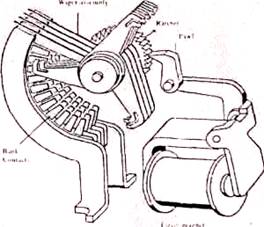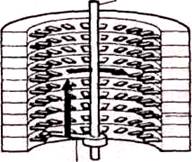Step by Step Switching or Strowger
Step by Step Switching or Strowger switching was the first automatic telephone system introduced by Almon B. Strowger. This system uses selectors for switching. The selectors used in Strowger exchange are mainly of two types
- Uniselector
- Two motion selector.
Both the selectors belong to the same types of switches called rotary switches.
UNISELECTOR
This is called uniselector because the rotary motion of this switch is in one direction, i.e., the wiper assembly moves only in one direction. The uniselector consists of moving contacts called wipers. These are used to make electrical connections with any one of several contacts, called bank contacts, in an arc around it. The arc in most cases consists of ten steps. The wiper assembly is divided into three sets of wipers so that the switch has to turn through only one third of a full circle when operated. These wipers are operated by an electromagnet, called driving magnet, with the help of a ratchet and pawl mechanism. When current flows through the windings of the driving magnet, it is energised and attracts the armature; the pawl slips over one tooth of the ratchet wheel. The ratchet is prevented from movement in the reverse direction by a detent. When the current stops through the windings of the driving magnet, it is de-energised, and the armature comes back to its rest position. During the reverse movement of the armature and hence that of the pawl, the ratchet wheel stop ahead in the clockwise direction by one tooth and the wipers move to the next contact. The uniselector rotates as many steps as the electromagnet is energised and de-energised. The schematic diagram of the uniselector is shown in the figure.

TWO MOTION SELECTOR
The two-motion selector is a type of rotary switch, in which the motion of the wiper assembly is in two directions, vertical as well as horizontal. In the vertical direction the wipers move upward to the desired level and make no connections with the bank contacts. While in the horizontal direction the wipers make connection with the bank contacts. The two-motion selector has 10 levels; each having 10 contacts, thus a total of 100 contacts are accessible.

Each contact represents the terminals of one switch of the higher stage or of one telephone line in the case of final selector. The dialing pulses cause the wiper assembly to step up or down to the desired level. If we take the example of a final selector, where up to 100 lines can be connected, the vertical and horizontal stepping of the selector are controlled by the digits dialed by the subscriber. When the first digit is dialed, the dialing pulses energise and de-encrgises the vertical magnet. The vertical magnet with the help of ratchet and pawl mechanism step up the wiper assembly, corresponding to the digit dialed. This is called vertical stepping.
When the second digit is dialed the dialing pulses are now diverted to another magnet, called horizontal magnet, with the help of a relay. These pulses energise and de-energise the horizontal magnet, which with the help of ratchet and pawl causes the wiper assembly to rotate to the proper contact, corresponding to the second digit dialed. This is called horizontal stepping. Thus the wiper assembly makes connection with the required number dialed by the subscriber. After completion of the call the wiper assembly comes back to the home position. For this purpose the rotary magnet is operated by the current and thus the wiper assembly moves through the remaining contacts of the level. A spring forces the wiper assembly to drop vertically and then to return horizontally to its normal position. Thus the two-motion selector does not require an additional magnet for its "homing process". This switch is also called a rectangular motion selector, because the wiper assembly moves along a rectangle:
vertical stepping rotary stepping dropping returning to its normal position.
